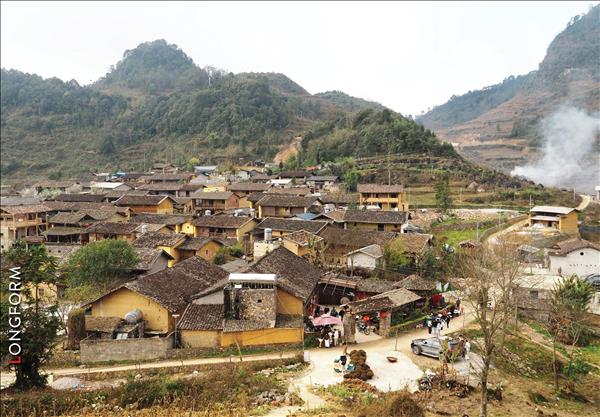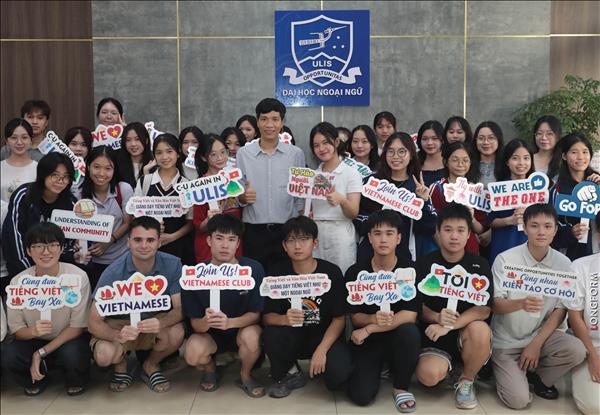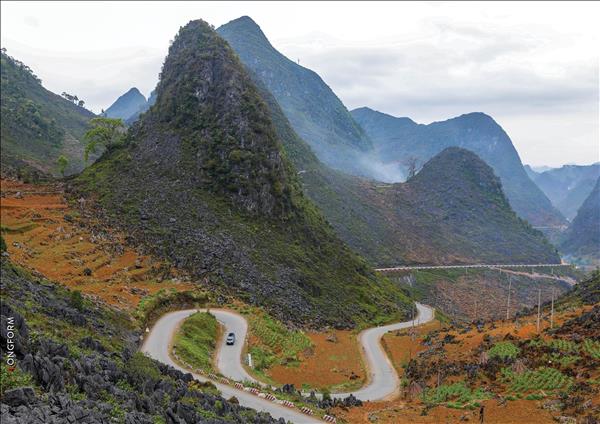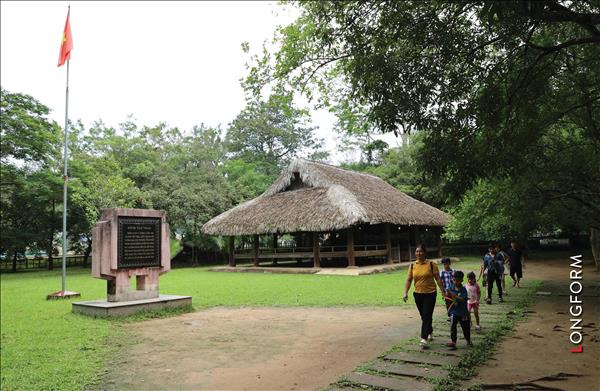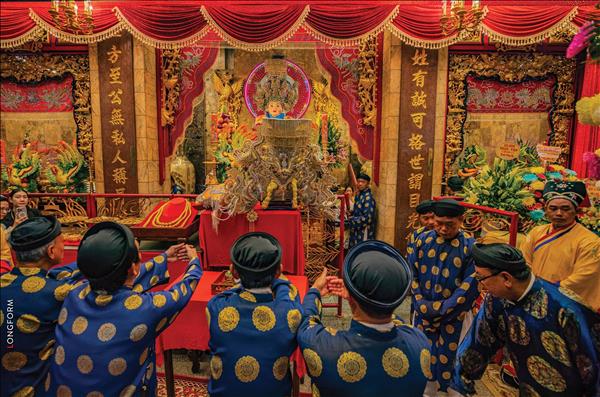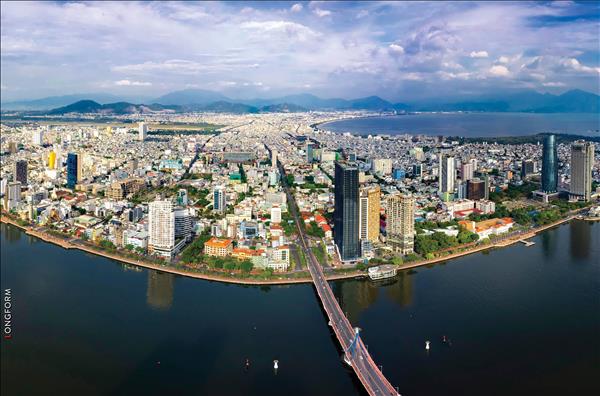A dream of going downstream of the Da river
Still fresh in my mind now are memories of a visit to La Hu hamlet in Muong Te district, Lai Chau province, nearly a decade ago, which have followed me through many years.
That was an afternoon of sadness. After a long and tiring day crossing hill after hill to mobilise in vain the La Hu pupils to go to school, Nguyen Huu Truong, principal of Pa U primary school, sat in a patched thatch-roof classroom, looking at the Da river and spoke sorrowfully, “I often wonder why the schooling is so miserably hard for La Hu children here and wonder when my pupils could go downstream of the Da river to Hanoi for a university education?”
Before my return to this difficult northernmost borderland, I remained obsessed with Truong’s confidence, trying my best to imagine how La Hu is now. Seeming to read my thoughts, a fellow traveller and a journalist in Lai Chau calmed me down, saying “My dear, the road to Muong Te now is extremely good with cars running smoothly”.
Even so, the images of a rough 300km- plus road characterised by hundreds of underwater passages and landslides I witnessed in the past appear before my eyes, worrying me a lot. Yet, my anxiety gradually disappeared along the asphalt road leading upstream. Thatched-roof houses along the road were replaced by red-tile houses in hamlets where there are new spacious schools.
Our car crossed a solid concrete bridge spanning the Da river, which replaced the old suspension one, to Bum To commune. From afar we could see a three-story built school near the mountains and forests. Bum To commune is considered the “capital” of the La Hu people, comprising eight hamlets inhabited by more than 3,000 people, accounting for one-third of the La Hu population in Vietnam.
Phung Gio Xo, the 24-year-old chief of Phin Kho hamlet, passionately told us about the study of the ethnic group, “Formerly, no hamlet children went to school. Since the government built roads and schools and mobilised the local people to construct hamlets and practice wet rice growing and raise cows and goats, the La Hu people have sent their children to schools”.
Phung Gio Xo’s words are backed up by Lo Thi Nguyet, principal of the semi-boarding primary school No.2 for ethnic minority children in Bum To. She said: “With dedicated teachers in the schools and hamlets, Bum To commune has, so far, achieved the target of universal pre-school and primary education with 100% of eligible children going to school. Many have finished their college or university education and returned home, contributing their knowledge to local development”.
We continue our journey upstream to Nam Khao commune where the Cong live representing 65% of the national Cong population. It is beyond our belief that a fully furnished preschool stands in a far-flung mountainous area. Tran Thi Thuy Hang, principal of Nam Khao preschool revealed to us that the school was built in 2014 at a cost of more than five billion dong (220,000 us dollars) from the Lai Chau hydroelectric power resettlement program. Since the new school was built, the Cong have voluntarily sent their children to school in great numbers.
In addition to the spacious classrooms, the expense of semi-boarding pupils of Cong is provided by the Government with 363,000VND (16 us dollars) each, thus helping children eat and their parents feel at ease to farm.
The assistance program for ethnic minority children in Muong Te district is actively endorsed by communities and businesses, Vingroup built a spacious modern semi-boarding school for children of the Mang ethnic minority in Chung Trai commune, Nam Nhun district.
Perhaps, thanks to better schooling conditions, Ly Thi Hang, a ninth-grader of the Mang confidently told us: “Next year, I will sit for the entrance exams at Northwestern Culture and Art School so that I can study and preserve the distinctive dances of my people”.
During my trip this time I have no chance to meet Nguyen Huu Truong, as he was sent to university in the midland province of Thai Nguyen. The dream of going downstream of Da river by children of La Hu, Cong and Mang to university has come true now.
Forward Strides in the Border Region
When arriving at Nam Khao commune of Muong Te district, we were invited by Nam Muc hamlet chief Khoang Van Lan to attend a hamlet rite. Sorcerer Lo Van Cho, who performed principal ceremonies in hamlet rites, said as the economic life of Cong people gets better, my prayers must be added to new ideas. For instance, in cow and goat rearing, the prayers for no diseases are added or in water rice cultivation, such advice as weed pulling or field embankment are also added. “Such things,” the sorcerer added, “were not stated in prayers because animal rearing and wet rice farming were formerly not practiced in our nomadic life”.
We are told that in 2013, when Cong were relocated to resettlement hamlets, the administration of Muong Te district set up an inter-sector working team headed by the district People’s Committee Vice-President Tran Duc Hien. The team members stayed with people, ate with people, lived with people and worked together with people, teaching them the ways to grow wet rice and raise animals.
Hien recalled that team members went with people, reclaiming virgin land, building terraced fields for rice cultivation and teaching them to raise goats and cows and plant rubber trees. At night, they rallied young people to folk singing and traditional dancing. After only four years, more than 200 ha of wet rice and 110 ha of rubber were produced in Nam Khao commune. Now, Cong are self-sufficient in food.
La Hu people in Bum To commune also see wonderful development, freeing themselves from hunger and poverty. We followed commune health official Le Quang Hien on his trip to Phin Kho hamlet for periodical medical checks given to Phung Phi Mu, 96 years old. She told us about the revival of her people.
She could not remember how many harvests had failed and hunger was rampant all year round because the La Hu led a nomadic life on the mountains in border regions. She could remember clearly the bumper crops in recent years. She said: “Even in my dreams, I could not believe that some days I would live in a solid timber house, eat my fill of white rice and see and hear children reading what they have learned at school”.
Also in Bum To commune, the La Hu have strongly developed the cultivation of audible canna with the World Bank’s support in capital, strains and fertilisers. So far, more than 20ha have been planted with arrow canna in one crop a year. Phung Gio Xo, chief of Phin Kho hamlet, cultivates canna on more than one hectare, earning about 20 million dong (890 us dollars) a year in addition to some 30 million dong (1,300 us dollars) from goat rearing and growing cassava root.
We again go downstream to the legendary river intersection where the Da merges with the Nam Nam river, seeing the wonderful changes to the Mang in Trung Chai commune, Nam Nhun district.
The Mang are considered native people of the northwestern region. Prior to 2011 they lived in isolation, in danger of racial degeneration due to pre-consanguineous marriage, nomadic life and backward practices.
Just five years after implementing the Government’s 2011-2020 scheme on socio-economic development of areas inhabited by the Mang, La Hu, Cong and Co Lao, the Lai Chau administration brought a new atmosphere to hamlets of the Mang in Trung Chai in particular and Lai Chau in general.
Local people of various ethnic groups in Lai Chau often call it a husbandry “kingdom” with a lot of families raising dozens of cows, some with nearly 100 head.
Concluding the journey through areas inhabited by three ethnic minorities who had once led the most miserable life in Lai Chau province, my heart is buoyant with a feeling of a new life thriving in the upstream region of the Da river. There, the Cong, Mang and La Hu have been freed from their “yellow-leaf” destiny and step by step advanced forwards steadily with an abundant and peaceful life in the border region.
Story : Thong Thien Photos : Viet Cuong - Thong Thien
| Formerly, the La Hu, Cong and Mang ethnic minorities were nicknamed “yellow-leaf” because they led a wild, backwards and nomadic life. They built their lean-tos with jungle leaves for slash-and-burn farming, then moved to other places only when the roofing leaves turned yellow. |
That was an afternoon of sadness. After a long and tiring day crossing hill after hill to mobilise in vain the La Hu pupils to go to school, Nguyen Huu Truong, principal of Pa U primary school, sat in a patched thatch-roof classroom, looking at the Da river and spoke sorrowfully, “I often wonder why the schooling is so miserably hard for La Hu children here and wonder when my pupils could go downstream of the Da river to Hanoi for a university education?”
Before my return to this difficult northernmost borderland, I remained obsessed with Truong’s confidence, trying my best to imagine how La Hu is now. Seeming to read my thoughts, a fellow traveller and a journalist in Lai Chau calmed me down, saying “My dear, the road to Muong Te now is extremely good with cars running smoothly”.
Even so, the images of a rough 300km- plus road characterised by hundreds of underwater passages and landslides I witnessed in the past appear before my eyes, worrying me a lot. Yet, my anxiety gradually disappeared along the asphalt road leading upstream. Thatched-roof houses along the road were replaced by red-tile houses in hamlets where there are new spacious schools.
Our car crossed a solid concrete bridge spanning the Da river, which replaced the old suspension one, to Bum To commune. From afar we could see a three-story built school near the mountains and forests. Bum To commune is considered the “capital” of the La Hu people, comprising eight hamlets inhabited by more than 3,000 people, accounting for one-third of the La Hu population in Vietnam.
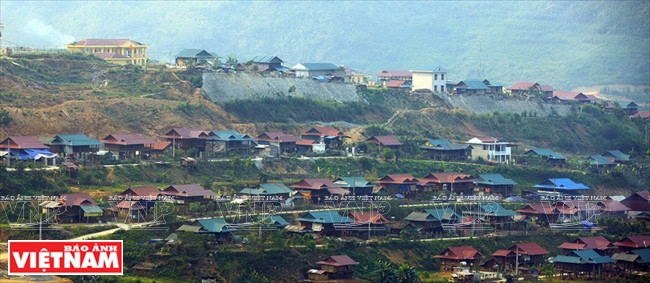 Nam Pung hamlet in Nam Khao commune was founded in 2014 after the relocation program for the Cong ethnic minority for the construction of Lai Chau hydropower plant. Photo: Thong Thien / VNP 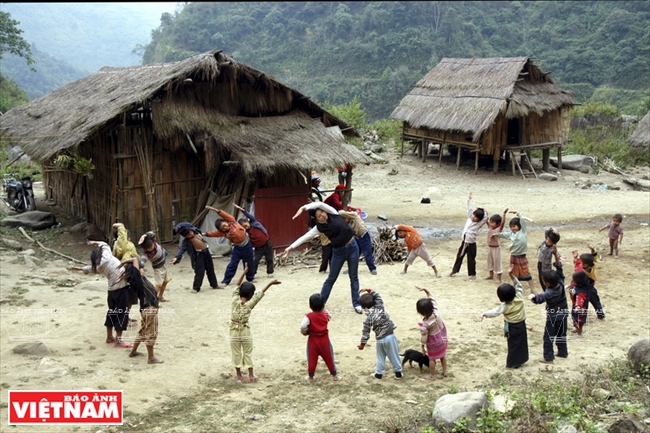 The kindergarten of the Mang ethnic minority in Nam Nhun district in 2007. At that time, most classrooms in the school were roofed with leaves. Photo: Thong Thien / VNP 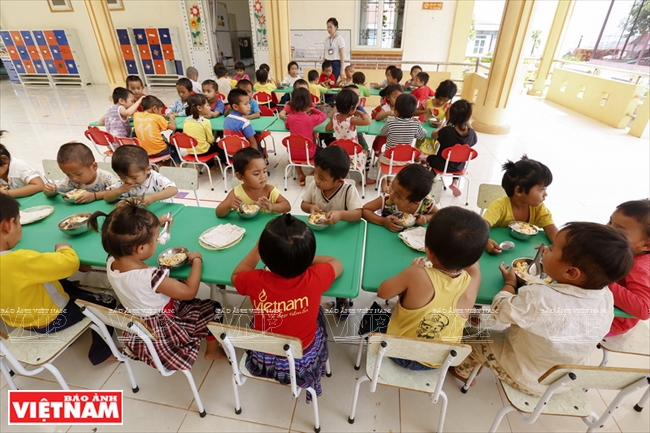 Lunch at the kindergarten in Nam Khao commune, which was funded by a project called “social-economic development in the areas of the Cong, Mang, La Hu and Co Lao ethnic minorities from 2011-2020”. Photo: Viet Cuong/VNP  Physical exercise class for Cong children at Nam Khao kindergarten. Photo: Thong Thien/VNP 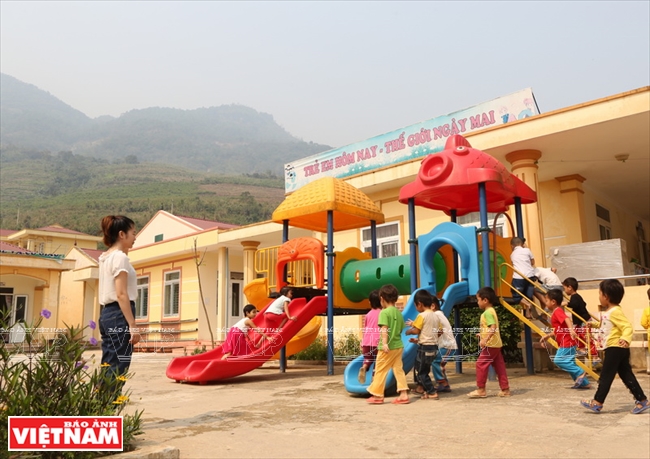 With an investment of 5 billion dong (220,000 US dollars), the Nam Khao kindergarten meets the national standard. Photo: Viet Cuong/VNP 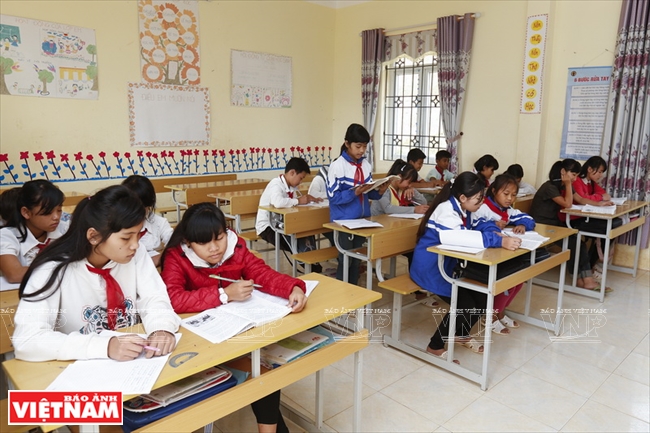 Before 2007, due to the distance from home to school (some 30km), the rate of drop out pupils was very high. Since 2015, with a new school, the graduation rate of the secondary school pupils in Bum To commune reached 90%. Photo: Viet Cuong/VNP 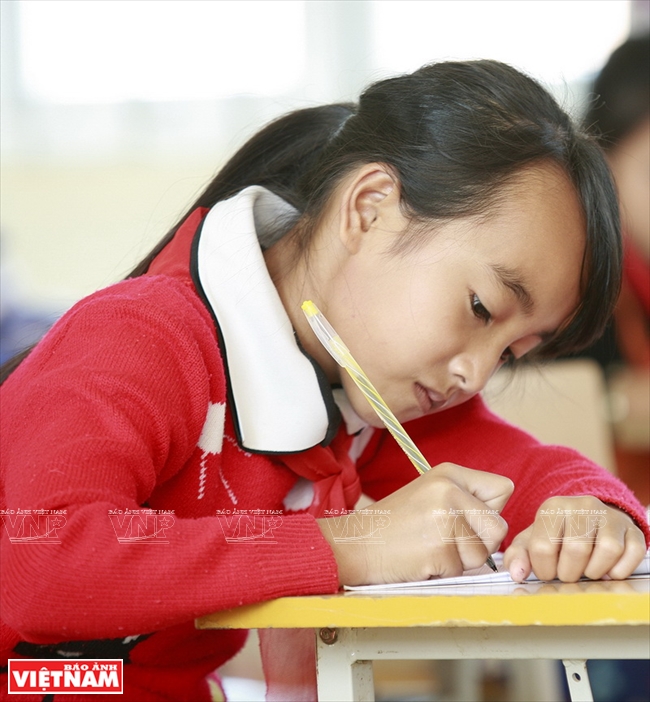 Ly Co Co, a fifth grade La Hu schoolgirl, received the outstanding mathematic award in 2016-2017. Photo: Viet Cuong/VNP  Pupils of the La Hu ethnic minority on the way home in Bum To commune. Photo: Viet Cuong/VNP |
| In May 2017, the Government issued the Decree No.57/2017/ND-CP prescribing the policies on enrollment priorities and study support for kindergarteners, pupils and students of 16 ethnic minorities with a population of less than 10,000, including Cong, Mang, La Hu, Pu Peo, Si La, Co Lao, Bo Y, La Ha, Ngai, Chut, O Du, Brau, Ro Mam, Lo Lo, Lu and Pa Then. |
Phung Gio Xo’s words are backed up by Lo Thi Nguyet, principal of the semi-boarding primary school No.2 for ethnic minority children in Bum To. She said: “With dedicated teachers in the schools and hamlets, Bum To commune has, so far, achieved the target of universal pre-school and primary education with 100% of eligible children going to school. Many have finished their college or university education and returned home, contributing their knowledge to local development”.
We continue our journey upstream to Nam Khao commune where the Cong live representing 65% of the national Cong population. It is beyond our belief that a fully furnished preschool stands in a far-flung mountainous area. Tran Thi Thuy Hang, principal of Nam Khao preschool revealed to us that the school was built in 2014 at a cost of more than five billion dong (220,000 us dollars) from the Lai Chau hydroelectric power resettlement program. Since the new school was built, the Cong have voluntarily sent their children to school in great numbers.
In addition to the spacious classrooms, the expense of semi-boarding pupils of Cong is provided by the Government with 363,000VND (16 us dollars) each, thus helping children eat and their parents feel at ease to farm.
The assistance program for ethnic minority children in Muong Te district is actively endorsed by communities and businesses, Vingroup built a spacious modern semi-boarding school for children of the Mang ethnic minority in Chung Trai commune, Nam Nhun district.
Perhaps, thanks to better schooling conditions, Ly Thi Hang, a ninth-grader of the Mang confidently told us: “Next year, I will sit for the entrance exams at Northwestern Culture and Art School so that I can study and preserve the distinctive dances of my people”.
During my trip this time I have no chance to meet Nguyen Huu Truong, as he was sent to university in the midland province of Thai Nguyen. The dream of going downstream of Da river by children of La Hu, Cong and Mang to university has come true now.
Forward Strides in the Border Region
When arriving at Nam Khao commune of Muong Te district, we were invited by Nam Muc hamlet chief Khoang Van Lan to attend a hamlet rite. Sorcerer Lo Van Cho, who performed principal ceremonies in hamlet rites, said as the economic life of Cong people gets better, my prayers must be added to new ideas. For instance, in cow and goat rearing, the prayers for no diseases are added or in water rice cultivation, such advice as weed pulling or field embankment are also added. “Such things,” the sorcerer added, “were not stated in prayers because animal rearing and wet rice farming were formerly not practiced in our nomadic life”.
We are told that in 2013, when Cong were relocated to resettlement hamlets, the administration of Muong Te district set up an inter-sector working team headed by the district People’s Committee Vice-President Tran Duc Hien. The team members stayed with people, ate with people, lived with people and worked together with people, teaching them the ways to grow wet rice and raise animals.
Hien recalled that team members went with people, reclaiming virgin land, building terraced fields for rice cultivation and teaching them to raise goats and cows and plant rubber trees. At night, they rallied young people to folk singing and traditional dancing. After only four years, more than 200 ha of wet rice and 110 ha of rubber were produced in Nam Khao commune. Now, Cong are self-sufficient in food.
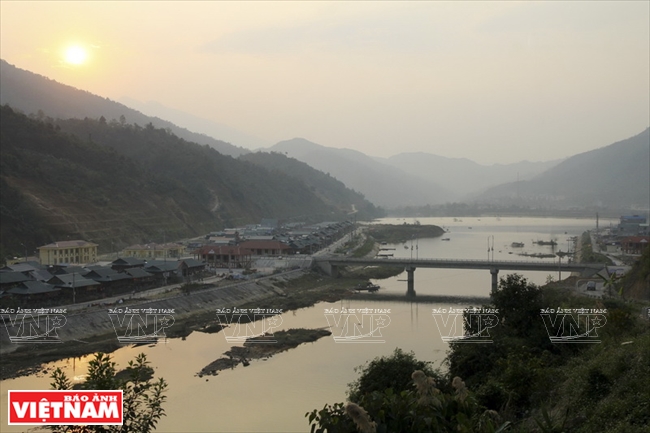 A corner of a relocation commune in Muong Te district Photo: Viet Cuong/VNP  A house in a relocation commune. Photo: Viet Cuong/VNP 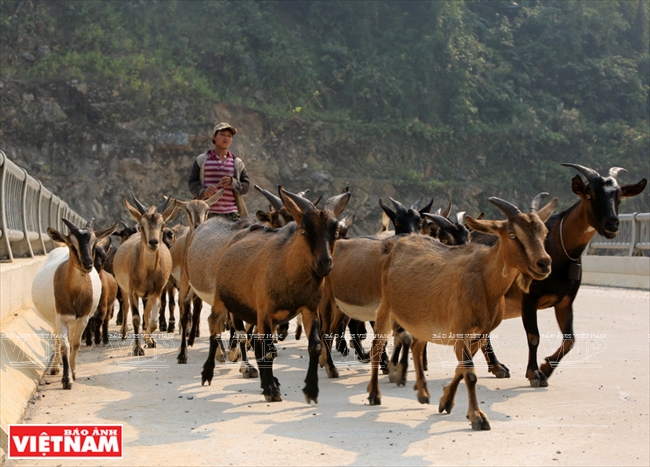 The herd of more than 100 goats owned by Chang E Xe in Nam Khao commune. Photo: Thong Thien/VNP 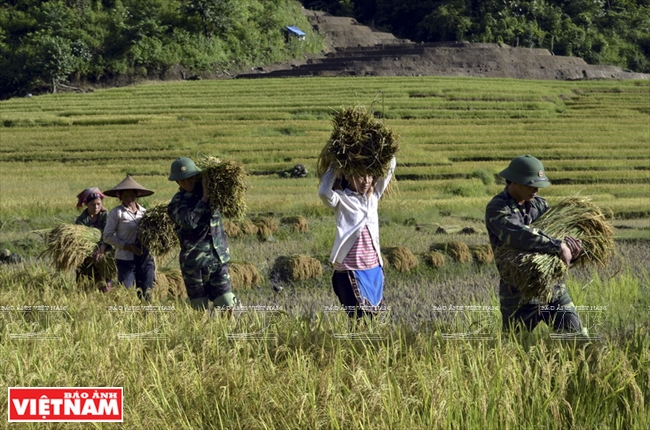 Soldiers help ethnic minorities harvest crops. Photo: Viet Cuong/VNP |
La Hu people in Bum To commune also see wonderful development, freeing themselves from hunger and poverty. We followed commune health official Le Quang Hien on his trip to Phin Kho hamlet for periodical medical checks given to Phung Phi Mu, 96 years old. She told us about the revival of her people.
She could not remember how many harvests had failed and hunger was rampant all year round because the La Hu led a nomadic life on the mountains in border regions. She could remember clearly the bumper crops in recent years. She said: “Even in my dreams, I could not believe that some days I would live in a solid timber house, eat my fill of white rice and see and hear children reading what they have learned at school”.
Also in Bum To commune, the La Hu have strongly developed the cultivation of audible canna with the World Bank’s support in capital, strains and fertilisers. So far, more than 20ha have been planted with arrow canna in one crop a year. Phung Gio Xo, chief of Phin Kho hamlet, cultivates canna on more than one hectare, earning about 20 million dong (890 us dollars) a year in addition to some 30 million dong (1,300 us dollars) from goat rearing and growing cassava root.
We again go downstream to the legendary river intersection where the Da merges with the Nam Nam river, seeing the wonderful changes to the Mang in Trung Chai commune, Nam Nhun district.
The Mang are considered native people of the northwestern region. Prior to 2011 they lived in isolation, in danger of racial degeneration due to pre-consanguineous marriage, nomadic life and backward practices.
Just five years after implementing the Government’s 2011-2020 scheme on socio-economic development of areas inhabited by the Mang, La Hu, Cong and Co Lao, the Lai Chau administration brought a new atmosphere to hamlets of the Mang in Trung Chai in particular and Lai Chau in general.
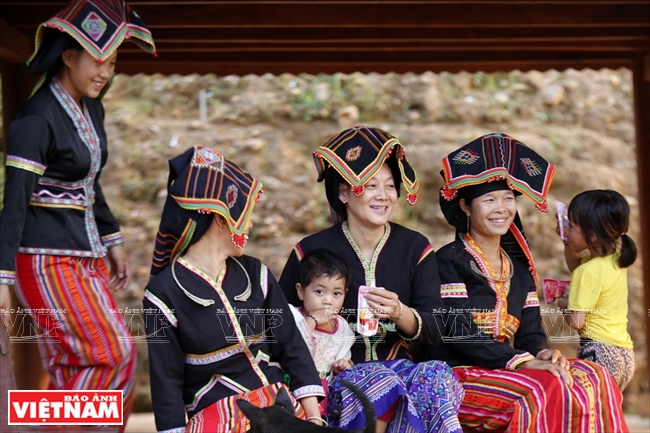 Cong women in their traditional dresses. Photo: Viet Cuong/VNP 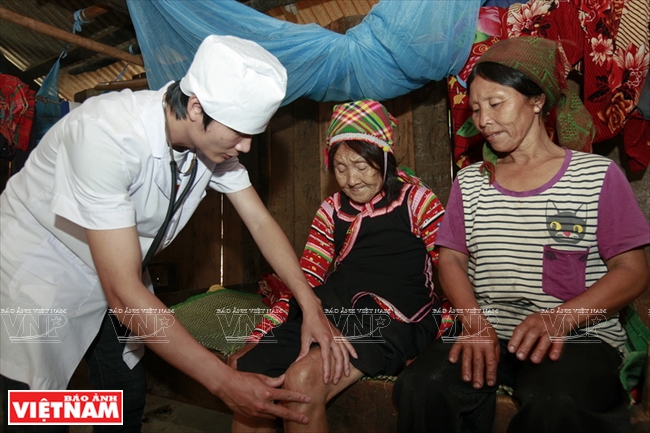 A doctor gives a regular medical check-up to Phung Phi Mu, 96, a La Hu woman, in Bum To commune. Photo: Viet Cuong/VNP 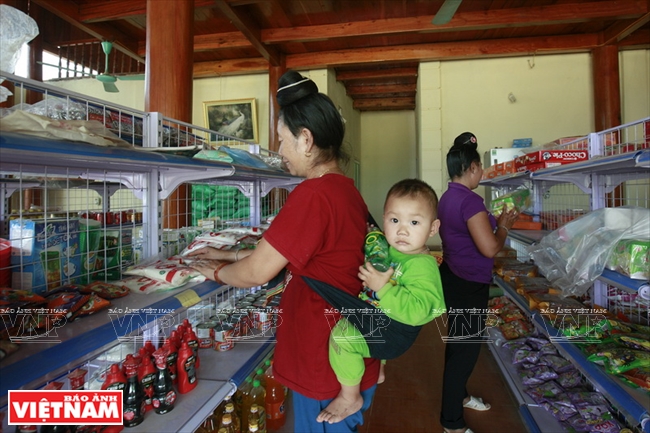 The Cong shopping at a small market. Photo: Viet Cuong/VNP 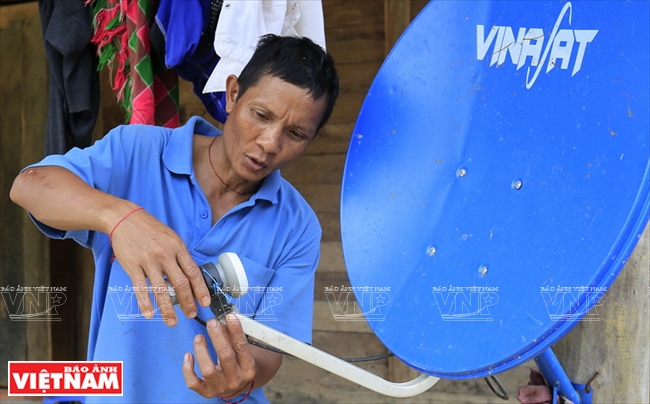 100% of ethnic minority people in the areas have access to mobile phones and television. Photo: Viet Cuong/VNP 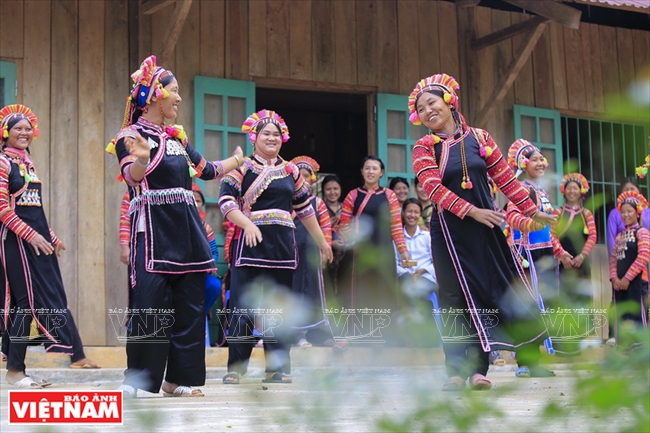 Members of the artistic group of La Hu ethnic minority in Bum To commune perform their traditional dance. Photo: Viet Cuong/VNP |
Local people of various ethnic groups in Lai Chau often call it a husbandry “kingdom” with a lot of families raising dozens of cows, some with nearly 100 head.
Concluding the journey through areas inhabited by three ethnic minorities who had once led the most miserable life in Lai Chau province, my heart is buoyant with a feeling of a new life thriving in the upstream region of the Da river. There, the Cong, Mang and La Hu have been freed from their “yellow-leaf” destiny and step by step advanced forwards steadily with an abundant and peaceful life in the border region.
|
|
Story : Thong Thien Photos : Viet Cuong - Thong Thien

